India-US Trade Pact: Navigating the Final Hurdles Before July 9


India and the US are nearing a trade pact before July 9. Discover the key challenges in agriculture and auto sectors and what it means for India.
The air is thick with anticipation as India and the United States push to finalise an interim trade pact, with the crucial July 9 deadline looming large. This agreement is more than just paperwork; it’s a strategic move to deepen economic ties and potentially double bilateral trade to a staggering $500 billion by 2030. However, like any significant negotiation, it comes with its share of sticking points, particularly in the agriculture and automotive sectors.
The July 9 Deadline: Why It Matters
The urgency around July 9 stems from the expiration of a 90-day suspension period on reciprocal tariffs imposed by the US. Without a deal, Indian exports could face a significant 26% tariff, adding to the existing 10% baseline duty. This could impact a wide array of Indian goods, from pharmaceuticals and textiles to auto components, making it a critical juncture for Indian businesses and exporters. Union Commerce Minister Piyush Goyal has firmly stated that India will not be pressured by deadlines and will only sign a deal that is truly in the nation’s best interest.
Agriculture: India’s “Red Line”
The agricultural sector remains the most sensitive and contentious issue in these talks. The US is keen on gaining greater market access for its agricultural products, including:
- Dairy items
- Apples
- Tree nuts
- Genetically Modified (GM) crops like maize and soybeans
However, India has consistently maintained a firm stance, considering agriculture a “big red line.” This is primarily due to:
- Livelihoods: Millions of Indian farmers, many operating on small landholdings, depend on this sector. Opening up to heavily subsidised US farm products could severely impact their livelihoods.
- Food Security: Concerns about potential market disruption, food security standards, and even cultural and religious practices related to dairy products are paramount.
- GM Crops: India has a strong position against GM food crops, while US production heavily relies on them. This is a major point of disagreement, though discussions around a “self-certification” mechanism for GM-free imports are reportedly underway.
India has historically protected its dairy sector in all its free trade agreements, and this stance is unlikely to change.
Automotive Sector: Tariffs and Market Access
Another significant area of contention is the automotive sector. The US is seeking duty concessions on industrial goods and automobiles, particularly electric vehicles. On the other hand, India has raised concerns about the 25% duty imposed by the US on passenger vehicles, light trucks, and certain automobile parts originating from India. India has even informed the WTO of its right to impose retaliatory duties in response to American tariffs on steel and aluminium, which also affect auto parts.
While India might consider allowing increased imports of high-end automobiles like luxury cars, the overall aim is to protect its domestic manufacturing base. The discussions also involve India pushing for duty concessions on labour-intensive sectors, including:
- Textiles
- Gems and jewellery
- Leather goods
- Garments
- Plastics
- Chemicals
- Shrimp
- Oil seeds
- Grapes
- Bananas
The Road Ahead
Despite the challenges, both nations are committed to finding common ground. The current interim pact is seen as a stepping stone towards a more comprehensive Bilateral Trade Agreement (BTA) targeted for September-October this year. This phased approach allows both sides to secure “quick, easy wins” by lowering tariffs in less sensitive sectors, while pushing the more complex issues, like agriculture and dairy, down the road for further negotiations.
The success of this trade pact is crucial not just for economic growth but also for strengthening the overall strategic partnership between India and the US. As the deadline approaches, the world watches keenly to see if these two economic powerhouses can bridge their differences and forge a mutually beneficial path forward.
Recent Posts
A Gang’s Chilling Warning to Bollywood after the Kapil Sharma Cafe Attack
A recent incident at actor-comedian Kapil Sharma’s cafe has sent a chilling message through the… Read More
Modi and Putin’s Crucial Talk: Strengthening Ties Amid Global Tensions
Narendra Modi and Russian President Vladimir Putin recently held an important conversation, reaffirming the strong… Read More
The Bull and Bear Tussle: How Trump’s Tariffs Are Shaking Up the Indian Stock Market
Indian stock markets are on edge after new US tariffs. Will the Nifty50 and Sensex… Read More
Hope Amidst the Uttarkashi Flash Floods: Families Await News
Anxious families in Uttarkashi wait for news after flash floods. Discover the ongoing rescue efforts… Read More
India’s Unwavering Pledge: Farmers’ Interests Paramount, Says PM Modi
The nation recently witnessed a strong and clear message from Prime Minister Narendra Modi regarding… Read More
Beyond Flavor: Unveiling the Healing Powers of Indian Spices
Indian cuisine is renowned worldwide for its vibrant flavors and aromatic spices. However, these culinary… Read More